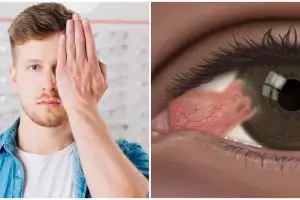Brilio.net - Recently it was rumored that comedian Adul was suffering from vision problems. Some even suspected he was blind. This rumor first emerged during Pandji Pragiwaksono's video content with Kiky Saputri, where he talked about Adul's unhealthy condition so that his vision was impaired.
Not long after, Adul appeared on one of the television station's live programs and stated that he was not blind. Adul admitted that there was a problem in the fatty membrane or in the medical world known as pterygium.
Even though the pterygium he was suffering from did not bother him, the doctor said he needed surgery. So what is pterygium, the eye disease that comedian Adul suffers from? Come on, take a look at the complete review reported by brilio.net from various sources on Tuesday (25/6).
Know what pterygium is?

photo: freepik.com
Pterygium is a disease of the growth of tissue or 'flesh' in the eye. Adapting from the American Academy of Ophthalmology, this disease is also known as surfer's eye, which is characterized by the presence of a triangular-shaped membrane in the white part of the eyeball or in the conjunctiva.
When you have pterygium it can cause redness, swelling, or even irritation of the eye. If left alone, this membrane is at risk of growing, causing the quality of vision to decrease.
Conditions like this can occur due to thickening of the tissue in the conjunctiva that appears in one eye or both eyes. The growth process of this tissue membrane starts from the corner of the eye area, generally from the corner of the eye which is near the nose. Over time it can spread slowly or it can also stop at a certain point.
If the growth of the pterygium affects the cornea of the eye or covers the pupil, it can result in a person's vision being impaired. But, pterygium is needed, not eye cancer. However, this membrane can be annoying because it feels like there is something stuck in the eye, making it prone to irritation or severe redness.
Causes of pterygium.
Adapting from ASSIL Gaur Eye Institute of Los Angeles, the exact cause of pterygium has not yet been found. However, generally people who experience this disease are people who often do outdoor activities. For example, people who are often exposed to sunlight, pollution, hot and dry weather.
Apart from that, eyes that are often dry and exposed to foreign objects such as dust, sand, smoke and wind are also thought to be a trigger for pterygium. If you have this disease, it can be characterized by the appearance of pinguecula or lumps on the conjunctiva due to a buildup of calcium, protein or fat in the eyes.
People who are at risk of developing pterygium in the eye include:
1. Exposure to ultraviolet light (from the sun or other sources)
2. Live in a hot climate
3. Located in a dry and dusty climate
4. Spending a lot of time outdoors, where people who work outdoors can increase the risk by up to 150%.
5. Complications of dry eye disease
Symptoms of pterygium.
photo: freepik.com
The growing membrane generally does not cause other complaints. However, it can cause several symptoms, including:
1. Red, irritated and swollen eyes.
2. Eyes are dry, itchy, sore, and a burning sensation appears.
3. Watery eyes.
4. Feels like there is sand or a lump in the eye.
Furthermore, if the condition of the pterygium membrane spreads further, sufferers can experience various other symptoms, for example:
1. Damages the appearance due to the increasing size of the membrane.
2. Vision becomes blurred or double. This can happen if the pterygium grows until it touches the chorea or covers the pupil of the eye.
Pterygium treatment steps.
photo: freepik.com
Generally, pterygium does not require serious treatment if it does not cause complaints other than the appearance of the membrane.
If you experience redness or irritation due to pterygium, then treatment is sufficient with eye drops or ointment containing corticosteroids or lubricants that reduce inflammation.
Apart from that, pterygium cannot be treated with eye drops or ointment. Or you may even feel your vision is decreasing. So, surgery can be performed for aesthetic or beauty reasons.
How to prevent pterygium.
photo: freepik.com
Sun exposure is the first factor in the appearance of pterygium. Therefore, to prevent this eye disease, when you are outdoors you need to wear sunglasses or a hat. The goal is to avoid exposure to direct sunlight, smoke, or dust that can trigger pterygium.
Apart from that, it is best to keep your eyes moist by using artificial tear drops. This is to prevent pterygium recurrence and prevent dry eyes.
Finally, you can have your eyes checked by a doctor. The goal is to detect early possible eye problems. It is recommended to have an eye examination every 1-4 years for children and elderly people aged 40 years and over.
